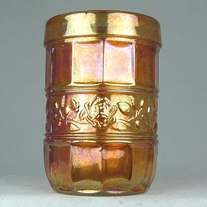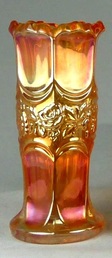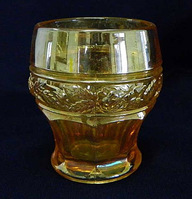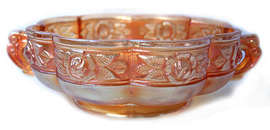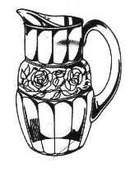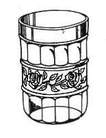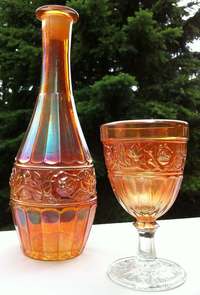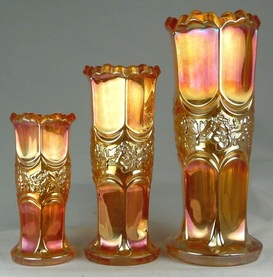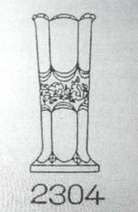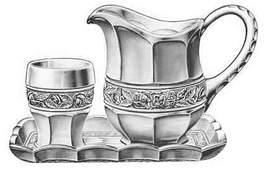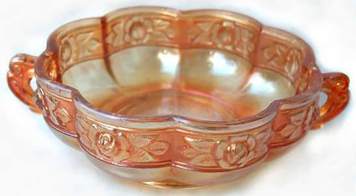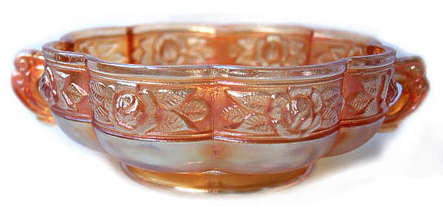Roses For You
Roses were a very popular motif for Carnival Glass used by most of the major glassmakers.
Most are very well known and readily recognised, but some do cause confusion. Here are some of the less well known rose patterns.
Most are very well known and readily recognised, but some do cause confusion. Here are some of the less well known rose patterns.
|
Rosas aka Band of Roses - Cristalerias Piccardo, Argentina
In the Cristalerias Piccardo 1933-34 catalogue, a whole range of items were illustrated in this pattern, including a water pitcher and tumbler, as shown on the right. A water pitcher was also depicted in the catalogue as "irisado", but it isn't certain whether or not all the items shown in the catalogue were available as iridised items. A decanter with stopper was listed as "irisado" (iridised) in two different sizes: a larger one for port and a smaller one for liqueurs. Only marigold has so far been found. Shapes currently known are the tumbler, water pitcher, goblet, decanter set (complete with cordials), tumble-up and stemmed compote. The base is usually ground. As with Brockwitz "Ariadne" there are surely more examples of this pattern to be found. |
Rosas, aka Band of Roses, Cr. Piccardo decanter and wine. Courtesy Michael O'Brien
|
|
Rose and Drape
|
Rose and Drape vases are currently known in three sizes, as shown here. They are approx 4.5", 6" and 7.5" high, and have been found only in marigold. Our recent research uncovered the maker of these delightful vases, when we found them is a catalogue, shown below, from Zabkowice, Poland! |
|
Rose Band aka Ariadne - Brockwitz, Germany |
This Brockwitz pattern is often confused with the Argentinian Rosas / Band of Roses pattern made by Cristalerias Piccardo. They look alike and they have a similar name. Given the known links between Germany and Argentina, it is possible that the similarities are more than just coincidental. A wide range of shapes was illustrated in the Brockwitz catalogues, many more than those currently known in Carnival - more shapes of this magnificent pattern still likely to be found in Carnival. The items known in Carnival (marigold only) are water pitcher, tumbler, juice glass, decanter (with stopper) and stemmed wine glasses complete with matching, circular undertray. |
Note the shape of the Brockwitz tumbler, which narrows toward the base, and the handle of the pitcher has a "cut" design. The leaves of the roses are very finely detailed and the overall quality is typical Brockwitz excellence. The base is ground.
Aztec Rose - Jeannette Glass, USA
Aztec Rose - Jeannette Glass, USA
This two-handled dish is Aztec Rose, made in the USA by Jeannette from circa the 1950s. It's possible that the iridised pieces were possibly later still.
It is often mistaken for both Ariadne / Rose Band and Rosas / Band of Roses due to the similarity in the rose pattern design - in each case, the pattern comprises a horizontal band of cameo roses, and vertical panels.
But the only shape made by Jeannette in this pattern was this distinctive scalloped edge handled bonbon! It is often found in a range of painted-on colourways such as green & blue and red & gold amberina, as well as crystal and marigold. It measures 8" across the top, including the handles. These items are fairly plentiful and turn up frequently on eBay. We found the above example in an antique mall in San Antonio in the mid 1990s. It cost $20.
So how does this Late item differ from the Brockwitz and Piccardo patterns? Well, there's no quick fix with this dilemma. Study the examples shown - but be aware that there are surely shapes in both these patterns yet to be discovered. Also be aware that the pattern does change somewhat on different shapes, so hard and fast rules are not possible.
It is often mistaken for both Ariadne / Rose Band and Rosas / Band of Roses due to the similarity in the rose pattern design - in each case, the pattern comprises a horizontal band of cameo roses, and vertical panels.
But the only shape made by Jeannette in this pattern was this distinctive scalloped edge handled bonbon! It is often found in a range of painted-on colourways such as green & blue and red & gold amberina, as well as crystal and marigold. It measures 8" across the top, including the handles. These items are fairly plentiful and turn up frequently on eBay. We found the above example in an antique mall in San Antonio in the mid 1990s. It cost $20.
So how does this Late item differ from the Brockwitz and Piccardo patterns? Well, there's no quick fix with this dilemma. Study the examples shown - but be aware that there are surely shapes in both these patterns yet to be discovered. Also be aware that the pattern does change somewhat on different shapes, so hard and fast rules are not possible.
